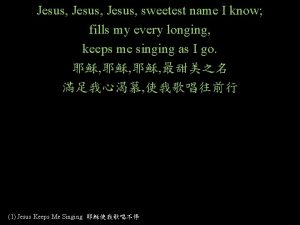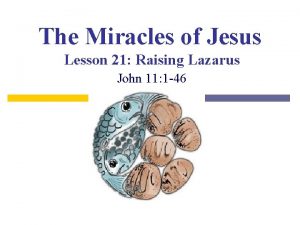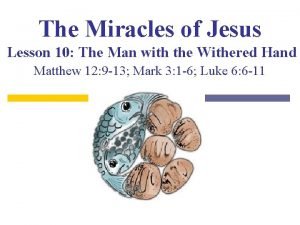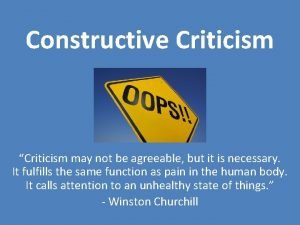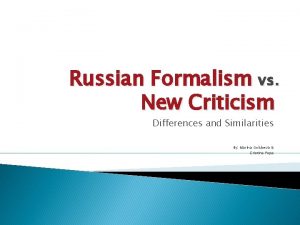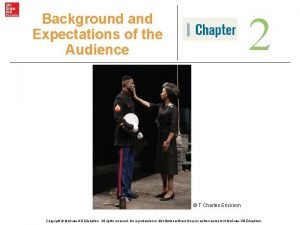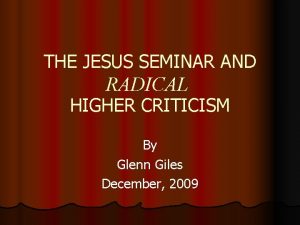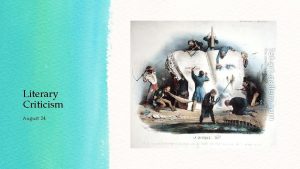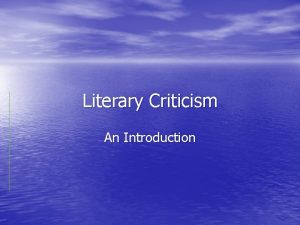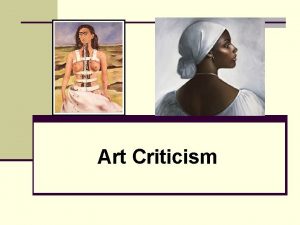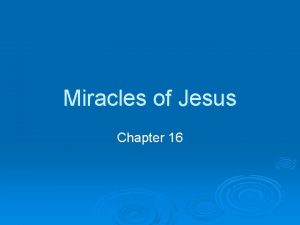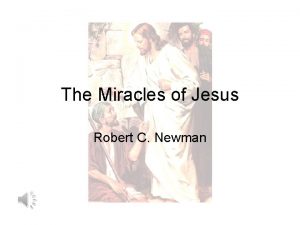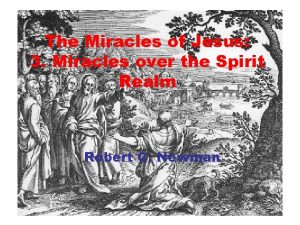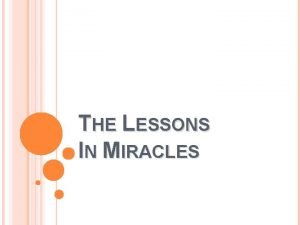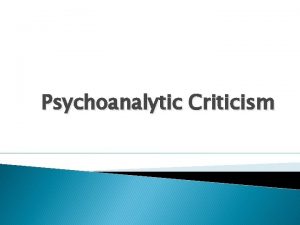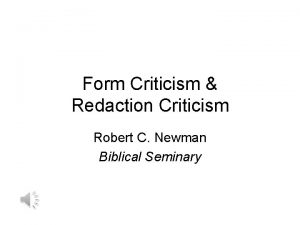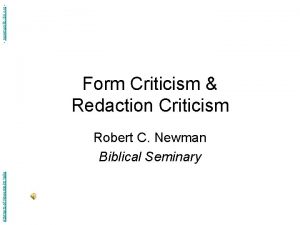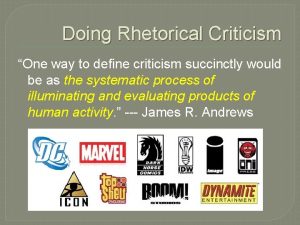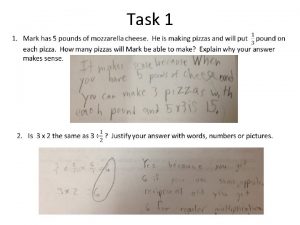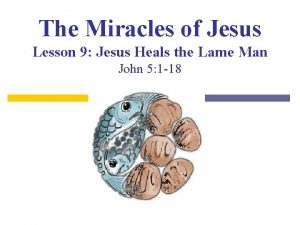MIRACLES MIRACLES OF JESUS FORM CRITICISM One task




















- Slides: 20

MIRACLES

MIRACLES OF JESUS

FORM CRITICISM

One task of form criticism is to study many stories of one genre in order to determine a typical pattern for that genre. For example most English ‘fairy tales’ begin with ‘once upon a time…’ then develop some sort of conflict, then show the hero resolves the problem, and finally end with “…and they lived happily ever after. ”

In the New Testament, most healing miracles are narrated according to a fairly regular pattern that typically consist of five stages: 1. Introduction: a geographical/temporal setting is given: the condition of the sick person is described; the healer encounters the sick person or they are brought to the healer, or at least someone tells the healer about them. 2. Conflict /Delay: often the healer investigates what the sick person wants or needs; sometimes the healer hestitates or tests the sick person’s readiness to be healed; sometimes other persons intervene or delay the healing. 3. Healing Action: the healing itself might be brought about verbally, or through a simple touch, or through more elaborate therapeutic means (using spittle, oil etc. ) Sometimes the healing action is only implied, but not explicitly described. 4. Confirmation: the fact that the healing has taken place is either asserted by the narrator or demonstrated through some action –performed by the person who has healed (standing up, walking, speaking etc. ) 5. Reaction: usually some reaction from those who witnessed the event is reported. In the Gospels, this response is often positive (giving praise to God), but sometimes there are negative reactions for some opponents. Photo by DAVIDCOHEN on Unsplash • Form Criticisim by Felix Just S. J Ph. D

“Form Criticism” also carefully analyses particular stories so as to see how typical or how unusual they are for their genre. If a particular narrative omits or adds some stages, or if in a certain stage it says something different from what you would expect, then we should ask why the author has not followed the typical pattern as what he or she is emphasizing in the story.

Thus in the NT, some healing miracles omit the “Reaction” stage, others have a much longer “Conflict” stage than normal. Many have only a very brief description of the actual healing, but some have a more detailed “Action” stage. A careful analysis of several miracle stories leads to some interesting conclusion abut the different messages of the different evangelists.

MARK 2: 1 -12 Detailed analysis

MARK 2: 1 -12 INTRODUCTION Detailed Analysis 2: 1 -3 CONFLICT/DELAY 2: 4 -10 Much more extensive than usual HEALING ACTION 2: 11 only Words CONFIRMATION By action 2: 12ª REACTION Amazed & give glory 2: 12 B

DETAILED ANALYSIS Matt 9: 1 -8 • Jesus got into a boat and crossed back over to the town where he lived. [a] 2 Some people soon brought to him a crippled man lying on a mat. When Jesus saw how much faith they had, he said to the crippled man, “My friend, don’t worry! Your sins are forgiven. ” 3 Some teachers of the Law of Moses said to themselves, “Jesus must think he is God!” 4 But Jesus knew what was in their minds, and he said, “Why are you thinking such evil things? 5 Is it easier for me to tell this crippled man that his sins are forgiven or to tell him to get up and walk? 6 But I will show you that the Son of Man has the right to forgive sins here on earth. ” So Jesus said to the man, “Get up! Pick up your mat and go on home. ” 7 The man got up and went home. 8 When the crowds saw this, they were afraid[b] and praised God for giving such authority to people.

MATT 9: 1 -8 INTRODUCTION 9: 1 -2ª CONFLICT/DELAY Shorter than Mark 9: 2 B-6ª HEALING ACTION Words only 9: 6 B CONFIRMATION By action 9: 7 REACTION Amazed & gave glory 9: 8 Detailed analysis

BY WHAT AUTHORITY? Strangely the Greek word for miracle, thauma, appears nowhere in the Gospels; they only say that the mighty acts and signs of Jesus aroused surprise and amazement. The word “miracle” derives from the Latin mirari, “to wonder at”. Miracles were not unique in the Greco-Roman world. What makes them different is the divine reference. Miracles at that time suggested God or the presence of the prince of darkness, Beelzebub.

MIRACLES AND JESUS’ IDENTITY Jesus did not work miracles for display, for his own advancement or comfort, for money, or to punish. In his healing miracles he identifies himself with people in fear and distress and hurt, in order to release and restore them: that is his identity

WORLD BEHIND THE TEXT • What can we learn about the context of this text? • What can be learn about the historical context of the author? • What do we know of the cultural world of the time? • What are the geographical considerations of this text? • Who authored, edited and translated this text? • What does the text reveal about the culture of the time? • When was the text written and what was happening at that time?

• Where does the text originate? • How has the text been communicated across time? (oral tradition, language in which it was first written) • Why was the text written or important enough to be retold across time? • What does the author want the audience to think or feel in reading this text? • Does the author draw on other texts in creating this one? • Why has the author chosen specific words or phrases? • What point of view does the author try to present? • What was happening around the author that caused them to create this text?

WORLD OF THE TEXT • What is actually in the text? • What type of writing is this text? • Is there a particular structure to this text? • What comes before and after this text? • Who are the characters in the text? • What happens in this text? • Who speaks and who is silenced? • Where does the story take place?

• Is the text attested to in other gospels or books of the bible? • What context clues help you to decide the type of text (greeting in a letter, sense of touch in a healing miracle, evocative language in a psalm)? • What is the most memorable or central scene in this text? Why is this scene central? • How do different parts of the text relate to each other? • What evidence can we find in the text of the historical, social, cultural, political and religious life of the time? • What words or interesting, new or difficult and need exploring?

WORLD IN FRONT OF THE TEXT • What meaning does this text have for my life today? • What might God want to say to us through this text today? • What might God want to say to me through this text? • What does the Church say about the meaning of this text? • What aspects of this text might not be relevant to our lives and time?

• How might people of different genders and cultures interpret this text differently? • How could this text be used in prayer? • Where can information about this text be found in order to interpret it for contemporary audience? • When might this text be used in contemporary contexts? • What life experiences help me to better understand this text?

Jesus and Exorcism • http: //catholic-resources. org/Bible/Exorcisms. htm Celsus’ criticism of Christianity • www. earlychristianwritings. com/celsus. html Illness, Disease and Cures in Antiquity WEBSITES : • www. localhistories. org/medicine. html Lepers, Leprosy in the Gospels • http: //homepages. which. net/~radical. faith/background/lep rosy. htm Sceptical/rationalist perspective on Miracles • www. miraclesceptic. com Into his own – perspectives on the world of Jesus - • http: //virtualreligion. net/iho/
 Definition of historical criticism
Definition of historical criticism Jesus is the sweetest name i know
Jesus is the sweetest name i know Jesus jesus jesus in the morning
Jesus jesus jesus in the morning Healing miracles of jesus
Healing miracles of jesus Lazarus miracles jesus
Lazarus miracles jesus Jesus heals man with withered hand lesson
Jesus heals man with withered hand lesson What are the 7 miracles jesus performed
What are the 7 miracles jesus performed Constructive criticism vs criticism
Constructive criticism vs criticism Difference between formalism and structuralism
Difference between formalism and structuralism Descriptive criticism vs prescriptive criticism
Descriptive criticism vs prescriptive criticism Tiered task bias task
Tiered task bias task Jesus seminar findings
Jesus seminar findings One empire one god one emperor
One empire one god one emperor One one one little dogs run
One one one little dogs run One king one law one faith
One king one law one faith One god one empire one emperor
One god one empire one emperor One ford plan
One ford plan See one do one teach one
See one do one teach one One price policy
One price policy One face one voice one habit and two persons
One face one voice one habit and two persons Studiendekanat uni bonn
Studiendekanat uni bonn

